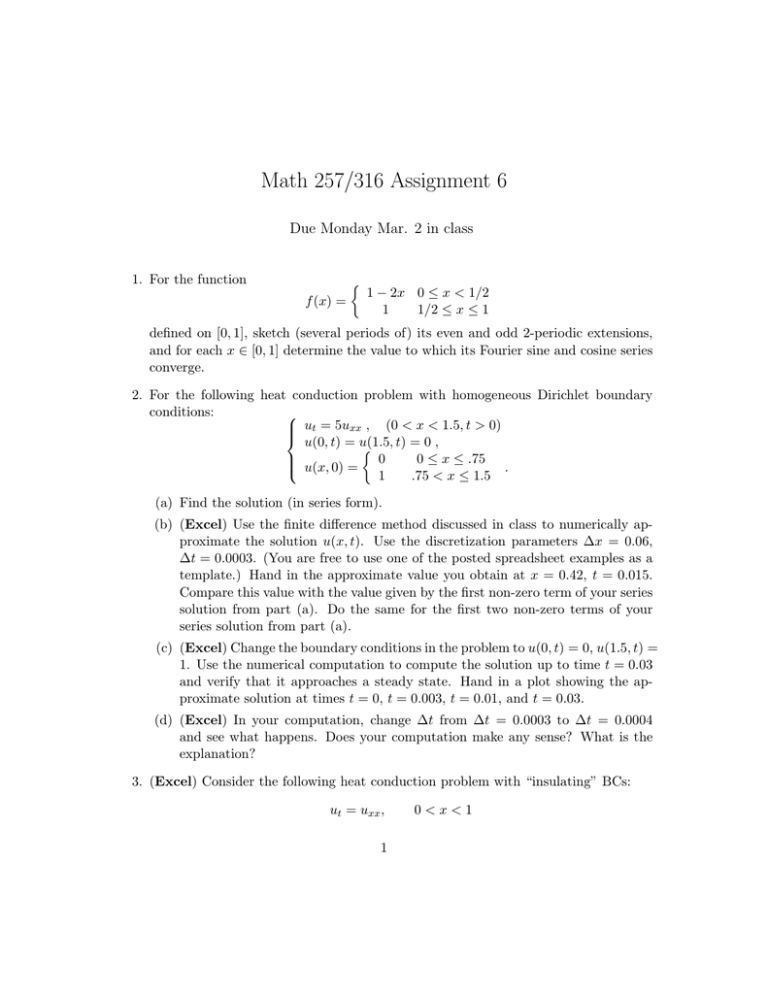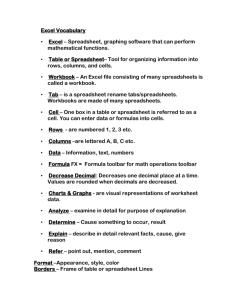Math 257/316 Assignment 6 Due Monday Mar. 2 in class
advertisement

Math 257/316 Assignment 6 Due Monday Mar. 2 in class 1. For the function f (x) = 1 − 2x 0 ≤ x < 1/2 1 1/2 ≤ x ≤ 1 defined on [0, 1], sketch (several periods of) its even and odd 2-periodic extensions, and for each x ∈ [0, 1] determine the value to which its Fourier sine and cosine series converge. 2. For the following heat conduction problem with homogeneous Dirichlet boundary conditions: ut = 5uxx , (0 < x < 1.5, t > 0) u(0, t) = u(1.5, t) = 0 , 0 0 ≤ x ≤ .75 . u(x, 0) = 1 .75 < x ≤ 1.5 (a) Find the solution (in series form). (b) (Excel) Use the finite difference method discussed in class to numerically approximate the solution u(x, t). Use the discretization parameters ∆x = 0.06, ∆t = 0.0003. (You are free to use one of the posted spreadsheet examples as a template.) Hand in the approximate value you obtain at x = 0.42, t = 0.015. Compare this value with the value given by the first non-zero term of your series solution from part (a). Do the same for the first two non-zero terms of your series solution from part (a). (c) (Excel) Change the boundary conditions in the problem to u(0, t) = 0, u(1.5, t) = 1. Use the numerical computation to compute the solution up to time t = 0.03 and verify that it approaches a steady state. Hand in a plot showing the approximate solution at times t = 0, t = 0.003, t = 0.01, and t = 0.03. (d) (Excel) In your computation, change ∆t from ∆t = 0.0003 to ∆t = 0.0004 and see what happens. Does your computation make any sense? What is the explanation? 3. (Excel) Consider the following heat conduction problem with “insulating” BCs: ut = uxx , 1 0<x<1 ux (0, t) = 0 and ux (1, t) = 0 0 if 0 ≤ x ≤ 1/2, u(x, 0) = f (x) = 1 if 1/2 < x ≤ 1, The solution is given by ∞ u(x, t) = a0 X 2 2 + an cos (nπx) e−n π t 2 n=1 where Z an = 2 ( 1 f (x) cos (nπx) dx = 0 1 2 sin − nπ n = 0, nπ 2 n > 0. [You should be able to find this solution yourself by separating variables - if you feel you need more practice, try to check it.] (a) Describe, with the aid of a sketch, how the temperature varies over time at the following points; (a) x = 0, (b) x = 1/2, (c) x = 1. To what value does the solution tend as t → ∞? (b) Now use an Excel spreadsheet and a finite difference approximation to solve the problem numerically, taking N = 10 (∆x = 0.1) and ∆t = 0.004 (you can use the template on the website, or your spreadsheet from assignment 5, but remember to account for the derivative boundary conditions). To what value does the solution appear to be converging as t → ∞? Why is this? How could you improve the numerical solution to get closer to the correct answer? 2




